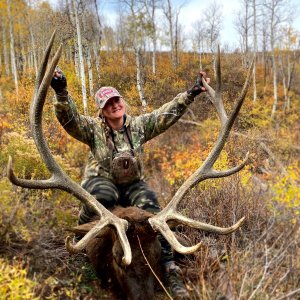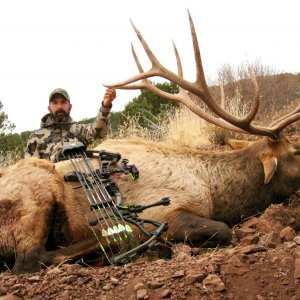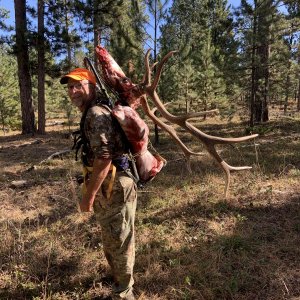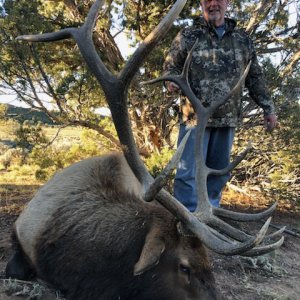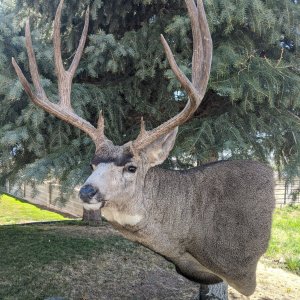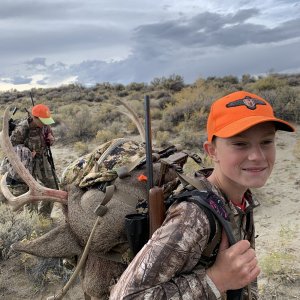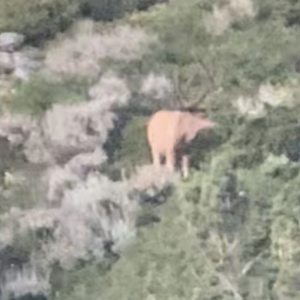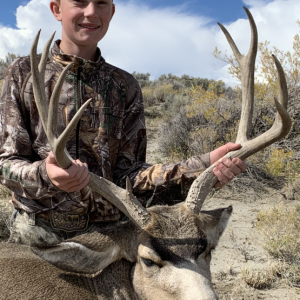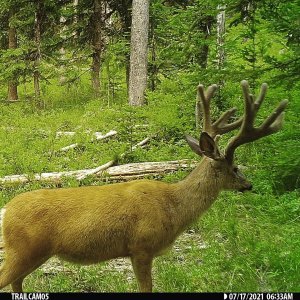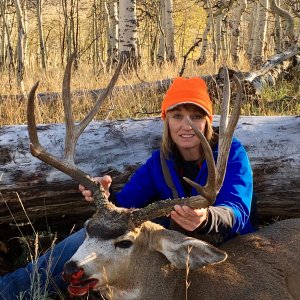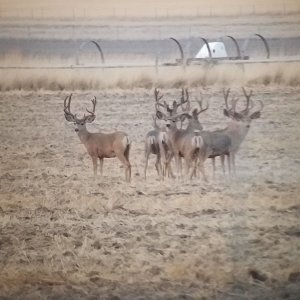llamapacker
Moderator
- Messages
- 1,068
There has been a fair bit in the news lately about the USFWS lifting the ban on elephant imports from much of southern Africa. Of course, the radical anti-hunting crowd has ratcheted up the rhetoric. The following article is a good reminder about looking at any animal species holistically as it interacts with the prevailing habitat.
Bill
________________________________________
THERE ARE FAR TOO MANY ELEPHANTS IN SOUTHERN AFRICA
By Ron Thomson
Don?t get me wrong. I love elephants. Next to the black rhino they are my favorite animal but, as they say in the classics: ?Enough is enough?.
The elephant is one of the most important animals in Africa at this time because the species has focused world attention on Africa. The continent's whole wildlife future rests on: (1) What we are going to do with our (own) elephants; or (2). What the rest of the world is going to allow us to do with our (own) elephants; or (3) how far we are going to allow the rest of the world to push us around - with regards to how they believe we should manage our (own) elephants. And the truth of the matter is that it seems neither they nor our own authorities, have any idea just what our management options are.
There is truly nothing mysterious about wildlife management; or about elephant management. The concept is actually very simple.
Management is the action that man takes to achieve a man-desired objective. There is nothing natural about wildlife management. It is man conceived; man designed; man implemented; man manipulated; and man is the principle beneficiary.
The next thing we have to understand is that - in terms of our options - mankind has three obligatory conservation priorities to consider. Our FIRST priority is to protect the SOIL and to use it sustainably and wisely - because without soil there would be no plants. Our SECOND priority is to protect and to use PLANTS sustainably and wisely - for without plants there would be no animals. Our THIRD and last priority is to protect and to sustainably, and wisely, utilize our ANIMALS. Animals come LAST on the list of our conservation priorities NOT because they are UNIMPORTANT but because they are LESS IMPORTANT than the soil and the plants.
Plants do a number of things in the environment. They produce food for herbivorous animals to eat; they provide cover for all animals - protecting them from the elements and hiding them from their enemies; they provide cover for the soil - protecting it from the erosive forces of the sun, wind and (especially) the rain; and finally - coupled with the physical character of their local environment - plants create the different habitat types to which all nature?s multifarious animal species are variously and specifically adapted.
Wild animals live quite happily - and sustainably - in the different habitats to which they are especially adapted, provided they don't over-utilize the habitat's core resources. Sustainability means they do not permanently change the quality or the quantity of the vegetation in which they live. In a nutshell, this means they can use (feed upon; break down; or cause the death of) any component part of the vegetation, provided the rate of their usage in any one year, does not exceed the degree to which nature can grow back the used parts of the plant community during the next year?s growing season. So, the basic nature of the habitats should not change from one year to the next. They should remain in a dynamically stable state!
There is only one species of savannah elephant (Loxodonta africana) and it lives in 37 countries (elephant range states) from one end of sub-Saharan Africa to the other. Within these countries it occurs in 150 different populations.
A POPULATION: is a group of animals of the same species the individuals of which interact with each other on a daily basis and they breed ONLY with other animals in the same group.
Elephants live quite happily in a range of habitats from monpane forests to lowland grasslands, savannahs, marshes and deserts. So they live in often vastly different habitat types each of which subjects the elephant populations that live within them, to widely different environmental conditions. Management plans for each elephant population, therefore, have to be drawn up separately. This fact dictates that the much vaunted endangered species concept is a fallacy. There is simply no one-size-fits-all (endangered species) management plan that can be applied universally to any animal species.
The ecological status of individual elephant populations can vary greatly. They can be UNSAFE, SAFE or EXCESSIVE; and these categories are related in large measure to the sustainable carrying capacities of their habitats.
The CARRYING CAPACITY of a habitat is the MAXIMUM number of elephants that can be permanently sustained without causing irreparable damage to the vegetation
Populations are UNSAFE when they exist in numbers well below the carrying capacity of their habitat; because they are not breeding well (so they are declining in number); and because the causes of the decline cannot be reversed. Such populations face eventual extinction.
Other populations are SAFE. They occur in good numbers - but not exceeding the carrying capacity of their habitat. They are fat and breeding well - because good food is abundant; and their numbers are expanding. SAFE populations should be culled annually - to keep their numbers uniformly stable (at a level below the carrying capacity of their habitat); and they can be utilized quite heavily by hunting or harvesting.
The third kind of population is the EXCESSIVE one - which, in number, greatly exceeds the carrying capacity of its habitat; is still expanding; persistently over-utilizes its habitat; causes massive habitat change; eliminates sensitive habitats; eventually extirpates all favored food resources; and causes massive species diversity losses.
By eliminating large trees and other shrubbery excessive elephant populations expose massive areas of bare ground to the most powerful soil erosion force in nature - tropical thunderstorms. And here the simple rain drop is the culprit. In Kruger National Park more than 95 percent of all top canopy trees in the park have been eliminated since 1960! This fact has huge negative ramifications on the health and stability of the park?s entire ecosystem, and is particularly destructive of its biological diversity. All other game reserves with excessive elephant populations are similarly affected.
Excessive elephant populations should be drastically reduced in number - in the first instance by no less than 50 percent.
Practically every elephant population south of the Zambezi and Cunene Rivers in southern Africa is excessive! This will give you some idea of the magnitude of the elephant management dilemma that southern Africa now faces.
Approximate population figures for just three of our national parks:
? Hwange NP (Zimbabwe) - 5000 sq. miles - 50 000 elephants;
? Gonarezhou NP (Zimbabwe) - 2000 sq. miles - 14 000 elephants;
? Kruger NP (South Africa) - 8 000 sq. miles - 20 000 elephants.
Botswana?s elephant sanctuary tallies (2013) (area not known) - 207 000.
Hwange is now carrying 20 times as many elephants per square mile as the figure recommended by the Rhodesian (now Zimbabwean) National Parks Board in 1960 (which was one elephant per two square miles).
Now consider the fact that the approximate sustainable elephant carrying capacities for all these game reserves is probably close to one elephant per two square miles. Work out the figures for yourselves; look at the numbers; and start to feel the uncomfortable quandary in which these facts now place us all. And remember, these national parks were created NOT for the uncontrolled proliferation of elephants - but with the priority objective of maintaining their overall biological diversities.
Now you will begin to understand why the Great Elephant Census (GEC) (2016) frustrated me so much. The elephant counts were made, no doubt to the best of the participants? capabilities; but the population numbers were distributed without the comparative elephant carrying capacity calculations for each of the game reserves in question. The count figures were truly, therefore, just a bunch of numbers. Without being able to determine whether the elephant populations were UNSAFE, SAFE or EXCESSIVE, the whole exercise was a great but worthless effort.
To drive this home: Everyone in Botswana was elated when the Botswana elephant count in 2013 reached over 200 000; but when it is considered that this population is GROSSLY EXCESSIVE - and that the management recommendation must be to reduce this population by half in the first management action - that is, by 100 000 elephants (and probably more later) - this puts an entirely different slant on the Botswana elephant numbers story. And it leaves no room for rejoicing!
What is abundantly clear is that the wildlife sanctuaries of southern Africa - if they are to survive into posterity - can sustainably maintain only a tiny fraction of the total numbers of elephants that the rest of the world expects us to carry.
--
Ron Thomson CEO - TRUE GREEN ALLIANCE
Cell: 072 587 1111
E-mail: [email protected]
TGA website: www.mahohboh.org
TGA Facebook: www.Facebook.com/TheTrueGreenAlliance
TGA Twitter: @TGA Mahohboh
Bill
________________________________________
THERE ARE FAR TOO MANY ELEPHANTS IN SOUTHERN AFRICA
By Ron Thomson
Don?t get me wrong. I love elephants. Next to the black rhino they are my favorite animal but, as they say in the classics: ?Enough is enough?.
The elephant is one of the most important animals in Africa at this time because the species has focused world attention on Africa. The continent's whole wildlife future rests on: (1) What we are going to do with our (own) elephants; or (2). What the rest of the world is going to allow us to do with our (own) elephants; or (3) how far we are going to allow the rest of the world to push us around - with regards to how they believe we should manage our (own) elephants. And the truth of the matter is that it seems neither they nor our own authorities, have any idea just what our management options are.
There is truly nothing mysterious about wildlife management; or about elephant management. The concept is actually very simple.
Management is the action that man takes to achieve a man-desired objective. There is nothing natural about wildlife management. It is man conceived; man designed; man implemented; man manipulated; and man is the principle beneficiary.
The next thing we have to understand is that - in terms of our options - mankind has three obligatory conservation priorities to consider. Our FIRST priority is to protect the SOIL and to use it sustainably and wisely - because without soil there would be no plants. Our SECOND priority is to protect and to use PLANTS sustainably and wisely - for without plants there would be no animals. Our THIRD and last priority is to protect and to sustainably, and wisely, utilize our ANIMALS. Animals come LAST on the list of our conservation priorities NOT because they are UNIMPORTANT but because they are LESS IMPORTANT than the soil and the plants.
Plants do a number of things in the environment. They produce food for herbivorous animals to eat; they provide cover for all animals - protecting them from the elements and hiding them from their enemies; they provide cover for the soil - protecting it from the erosive forces of the sun, wind and (especially) the rain; and finally - coupled with the physical character of their local environment - plants create the different habitat types to which all nature?s multifarious animal species are variously and specifically adapted.
Wild animals live quite happily - and sustainably - in the different habitats to which they are especially adapted, provided they don't over-utilize the habitat's core resources. Sustainability means they do not permanently change the quality or the quantity of the vegetation in which they live. In a nutshell, this means they can use (feed upon; break down; or cause the death of) any component part of the vegetation, provided the rate of their usage in any one year, does not exceed the degree to which nature can grow back the used parts of the plant community during the next year?s growing season. So, the basic nature of the habitats should not change from one year to the next. They should remain in a dynamically stable state!
There is only one species of savannah elephant (Loxodonta africana) and it lives in 37 countries (elephant range states) from one end of sub-Saharan Africa to the other. Within these countries it occurs in 150 different populations.
A POPULATION: is a group of animals of the same species the individuals of which interact with each other on a daily basis and they breed ONLY with other animals in the same group.
Elephants live quite happily in a range of habitats from monpane forests to lowland grasslands, savannahs, marshes and deserts. So they live in often vastly different habitat types each of which subjects the elephant populations that live within them, to widely different environmental conditions. Management plans for each elephant population, therefore, have to be drawn up separately. This fact dictates that the much vaunted endangered species concept is a fallacy. There is simply no one-size-fits-all (endangered species) management plan that can be applied universally to any animal species.
The ecological status of individual elephant populations can vary greatly. They can be UNSAFE, SAFE or EXCESSIVE; and these categories are related in large measure to the sustainable carrying capacities of their habitats.
The CARRYING CAPACITY of a habitat is the MAXIMUM number of elephants that can be permanently sustained without causing irreparable damage to the vegetation
Populations are UNSAFE when they exist in numbers well below the carrying capacity of their habitat; because they are not breeding well (so they are declining in number); and because the causes of the decline cannot be reversed. Such populations face eventual extinction.
Other populations are SAFE. They occur in good numbers - but not exceeding the carrying capacity of their habitat. They are fat and breeding well - because good food is abundant; and their numbers are expanding. SAFE populations should be culled annually - to keep their numbers uniformly stable (at a level below the carrying capacity of their habitat); and they can be utilized quite heavily by hunting or harvesting.
The third kind of population is the EXCESSIVE one - which, in number, greatly exceeds the carrying capacity of its habitat; is still expanding; persistently over-utilizes its habitat; causes massive habitat change; eliminates sensitive habitats; eventually extirpates all favored food resources; and causes massive species diversity losses.
By eliminating large trees and other shrubbery excessive elephant populations expose massive areas of bare ground to the most powerful soil erosion force in nature - tropical thunderstorms. And here the simple rain drop is the culprit. In Kruger National Park more than 95 percent of all top canopy trees in the park have been eliminated since 1960! This fact has huge negative ramifications on the health and stability of the park?s entire ecosystem, and is particularly destructive of its biological diversity. All other game reserves with excessive elephant populations are similarly affected.
Excessive elephant populations should be drastically reduced in number - in the first instance by no less than 50 percent.
Practically every elephant population south of the Zambezi and Cunene Rivers in southern Africa is excessive! This will give you some idea of the magnitude of the elephant management dilemma that southern Africa now faces.
Approximate population figures for just three of our national parks:
? Hwange NP (Zimbabwe) - 5000 sq. miles - 50 000 elephants;
? Gonarezhou NP (Zimbabwe) - 2000 sq. miles - 14 000 elephants;
? Kruger NP (South Africa) - 8 000 sq. miles - 20 000 elephants.
Botswana?s elephant sanctuary tallies (2013) (area not known) - 207 000.
Hwange is now carrying 20 times as many elephants per square mile as the figure recommended by the Rhodesian (now Zimbabwean) National Parks Board in 1960 (which was one elephant per two square miles).
Now consider the fact that the approximate sustainable elephant carrying capacities for all these game reserves is probably close to one elephant per two square miles. Work out the figures for yourselves; look at the numbers; and start to feel the uncomfortable quandary in which these facts now place us all. And remember, these national parks were created NOT for the uncontrolled proliferation of elephants - but with the priority objective of maintaining their overall biological diversities.
Now you will begin to understand why the Great Elephant Census (GEC) (2016) frustrated me so much. The elephant counts were made, no doubt to the best of the participants? capabilities; but the population numbers were distributed without the comparative elephant carrying capacity calculations for each of the game reserves in question. The count figures were truly, therefore, just a bunch of numbers. Without being able to determine whether the elephant populations were UNSAFE, SAFE or EXCESSIVE, the whole exercise was a great but worthless effort.
To drive this home: Everyone in Botswana was elated when the Botswana elephant count in 2013 reached over 200 000; but when it is considered that this population is GROSSLY EXCESSIVE - and that the management recommendation must be to reduce this population by half in the first management action - that is, by 100 000 elephants (and probably more later) - this puts an entirely different slant on the Botswana elephant numbers story. And it leaves no room for rejoicing!
What is abundantly clear is that the wildlife sanctuaries of southern Africa - if they are to survive into posterity - can sustainably maintain only a tiny fraction of the total numbers of elephants that the rest of the world expects us to carry.
--
Ron Thomson CEO - TRUE GREEN ALLIANCE
Cell: 072 587 1111
E-mail: [email protected]
TGA website: www.mahohboh.org
TGA Facebook: www.Facebook.com/TheTrueGreenAlliance
TGA Twitter: @TGA Mahohboh

